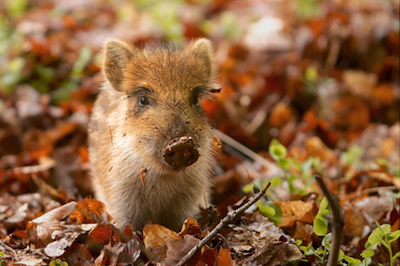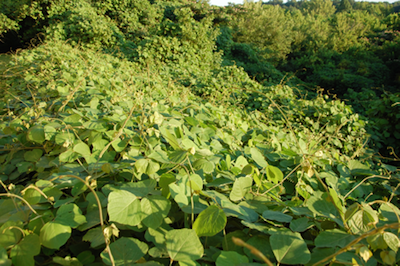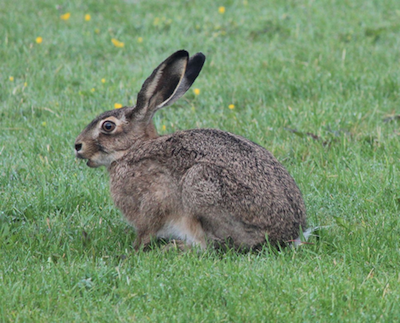The current wild pig population in the US is estimated at about 6 million, and it’s only increasing from there…
 If there’s one thing pigs do well, besides destruction, it’s reproduction. The gestation length for pigs is about 114 days (3 months, 3 weeks, 3 days—memory trick from vet school). They don’t require a whole lot of time between litters either. In fact, the goal for most commercial pig producers is to have each sow produce five litters every two years with an average litter size of 10-12 piglets. Due to increased threats to piglet survival and variable nutrient availability, average litter sizes in the wild are decreased to a meager eight piglets. Sows can become sexually mature at around six months of age, and life spans are estimated at about five years. That translates to about 11 litters of 8 piglets each—88 direct progeny from one sow in just five years! But remember, just several months after the first litter is born, those female offspring start having litters of their own…
If there’s one thing pigs do well, besides destruction, it’s reproduction. The gestation length for pigs is about 114 days (3 months, 3 weeks, 3 days—memory trick from vet school). They don’t require a whole lot of time between litters either. In fact, the goal for most commercial pig producers is to have each sow produce five litters every two years with an average litter size of 10-12 piglets. Due to increased threats to piglet survival and variable nutrient availability, average litter sizes in the wild are decreased to a meager eight piglets. Sows can become sexually mature at around six months of age, and life spans are estimated at about five years. That translates to about 11 litters of 8 piglets each—88 direct progeny from one sow in just five years! But remember, just several months after the first litter is born, those female offspring start having litters of their own…
Let’s do some math: If each of those litters is split 50/50 between males and females, the original sow could produce four females about every five months after reaching sexual maturity. Six months after the first four females are weaned, they enter sexual maturity and will produce their first litter at approximately 10 months of age. They will all continue to produce new litters every five months or so, and those new litters will soon follow suit. This cycle never stops! By the end of three years, that one sow could be responsible for about 500 females, each ready to add their own 500 to the population!
Thankfully, there is variability due to environmental conditions, hunting efforts, resource restraints, and other factors that prevents each sow from reaching those lofty reproductive goals year to year, but the population growth is still, at this point, out of control. It’s easy to see why the biologists say just to keep the population in check, we need to eliminate at least 60% each year. But is that possible? We’re going to need a lot of bullets and a lot more hunters.
What’s the worst part of this problem? Pigs are not even supposed to be in the US! They are taking precious resources from the ecosystem that belong to our white-tailed deer, turkey, and other native species. They prey on the eggs and hatchlings of ground-nested birds. They can decimate populations of reptiles and amphibians. Even small mammals and newborn foals are at risk of predation. And don’t forget all the plant species at risk.
 Unfortunately, this is not the first time that man’s interference in ecology and biology has brought about negative effects. If you’ve been to the southeastern US, you know we suffer from a little problem called Kudzu. This vine was originally brought over from Asia due to its ornamental qualities. After realizing it could grow at a rate of one foot per day, it began to be used as erosion control. It soon engulfed farms and forests—destroying natural plant life and eliminating natural habitat. Cotton was once “king” of the South, but it did not take Kudzu long to strip it of that title. In the height of its use, some farmers were noted as saying the proper way to plant Kudzu is to “drop the seeds and run!” It is estimated that Kudzu now covers over 7 million acres of land in the US.
Unfortunately, this is not the first time that man’s interference in ecology and biology has brought about negative effects. If you’ve been to the southeastern US, you know we suffer from a little problem called Kudzu. This vine was originally brought over from Asia due to its ornamental qualities. After realizing it could grow at a rate of one foot per day, it began to be used as erosion control. It soon engulfed farms and forests—destroying natural plant life and eliminating natural habitat. Cotton was once “king” of the South, but it did not take Kudzu long to strip it of that title. In the height of its use, some farmers were noted as saying the proper way to plant Kudzu is to “drop the seeds and run!” It is estimated that Kudzu now covers over 7 million acres of land in the US.
Hawaii introduced the mongoose to its islands in an attempt to eliminate a rodent problem about 100 years ago. What do they have now? A rodent problem AND a mongoose problem. The mongooses effectively devoured everything except the rodents, including native birds, reptiles, and amphibians, driving some species into extinction. Domestic chickens are also a favorite target.
 If you really want to go down a rabbit trail, we’ll discuss some of Australia’s difficulties with invasive species. The European Rabbit was introduced in the 18th century for hunting, and the population soon exploded causing massive vegetation loss and erosion problems. A virus was intentionally released in 1950, but resistant rabbits had no problem repopulating the area. Research was conducted on another virus, which was “accidentally” released in the early 1990s, which wiped out millions of rabbits in horrific fashion, and still threatens the commercial and pet rabbits in the area today. The estimated population of the European Rabbit is still currently over 200 million. In 1935, the Cane Toad was introduced into Australia to protect sugar cane crops from the cane beetle. The population of cane toads has since matched its European Rabbit counterparts at 200+ million, and sugar cane is still plagued by the cane beetle. The cane toad has depleted other valuable insect resources for native animals and taken over valuable habitat. They also carry a potent toxin threatening native species that attempt to prey on the toads, which provides a great defense and lends to their further population expansion. Other problematic invasive species of Australia include red foxes, camels, feral goats, feral cats, and of course, feral pigs.
If you really want to go down a rabbit trail, we’ll discuss some of Australia’s difficulties with invasive species. The European Rabbit was introduced in the 18th century for hunting, and the population soon exploded causing massive vegetation loss and erosion problems. A virus was intentionally released in 1950, but resistant rabbits had no problem repopulating the area. Research was conducted on another virus, which was “accidentally” released in the early 1990s, which wiped out millions of rabbits in horrific fashion, and still threatens the commercial and pet rabbits in the area today. The estimated population of the European Rabbit is still currently over 200 million. In 1935, the Cane Toad was introduced into Australia to protect sugar cane crops from the cane beetle. The population of cane toads has since matched its European Rabbit counterparts at 200+ million, and sugar cane is still plagued by the cane beetle. The cane toad has depleted other valuable insect resources for native animals and taken over valuable habitat. They also carry a potent toxin threatening native species that attempt to prey on the toads, which provides a great defense and lends to their further population expansion. Other problematic invasive species of Australia include red foxes, camels, feral goats, feral cats, and of course, feral pigs.
Will we ever get rid of Kudzu in the South? Will Hawaii get control of those mongooses? Good luck to Australia…
So what about wild pigs in the US? What options do we have? How are we going to gain control? Hunting and trapping alone won’t get the job done. My money is on oral contraceptives, but who knows what kind of numbers we will be looking at by the time that is available. At that point, will we ever catch up? Let’s hope so for the sake of the ecosystem that we all love so much. In the mean time, grab your weapon of choice, plenty of ammo, and do your part!
-Chris
Photo Credits:
SUS SCROFA PIGLET – By Sander van der Wel (Frisling) [CC-BY-SA-2.0 (http://creativecommons.org/licenses/by-sa/2.0)], via Wikimedia Commons
KUDZU, the wild hog of the plant world – “KudzuPlants” by Bubba73 (Jud McCranie) – Own work. Licensed under Creative Commons Attribution-Share Alike 3.0 via Wikimedia Commons – http://commons.wikimedia.org/wiki/File:KudzuPlants.JPG#mediaviewer/File:KudzuPlants.JPG
EUROPEAN HARE – By Kim Hansen (Own work) [CC-BY-SA-3.0 (http://creativecommons.org/licenses/by-sa/3.0)], via Wikimedia Commons

